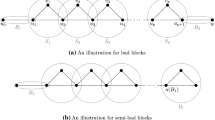Abstract
In a graph G of maximum degree Δ, let γ denote the largest fraction of edges that can be Δ edge-coloured. Albertson and Haas showed that \({\gamma \geq \frac{13}{15}}\) when G is cubic. We show here that this result can be extended to graphs with maximum degree 3, with the exception of a graph on 5 vertices. Moreover, there are exactly two graphs with maximum degree 3 (one being obviously the Petersen graph) for which \({\gamma = \frac{13}{15}.}\) This extends a result given by Steffen. These results are obtained by using structural properties of the so called δ-minimum edge colourings for graphs with maximum degree 3.
Similar content being viewed by others
References
Albertson M.O., Haas R.: Parsimonious edge colouring. Discret. Math. 148, 1–7 (1996)
Bondy J.A., Locke S.: Largest bipartite subgraphs in triangle free graphs with maximum degree three. J. Graph Theory 10, 477–504 (1986)
Fouquet J.-L.: Graphes cubiques d’indice chromatique quatre. Ann. Discret. Math. 9, 23–28 (1980)
Fouquet, J.-L.: Contribution à à l’ étude des graphes cubiques et problèmes hamiltoniens dans les graphes orientés. Ph.D. thesis, Université Paris SUD (1981)
Fouquet, J.-L., Vanherpe, J.-M.: A new bound for parsimonious edge-colouring of graphs with maximum degree three (2011). http://hal.archives-ouvertes.fr/hal-00516702/PDF/Parcimonious_15_17_Version_27_Feb_2011--.pdf
Fouquet, J.-L., Vanherpe, J.-M.: Tools for parsimonious edge-colouring of graphs with maximum degree three (2012). http://hal.archives-ouvertes.fr/hal-00502201/PDF/ToolsForParcimoniousColouring_Revision4_HAL.pdf
Isaacs R.: Infinite families of non-trivial trivalent graphs which are not Tait colorable. Am. Math. Mon. 82, 221–239 (1975)
König D.: Über Graphen und ihre Anwendung auf Determinantentheorie un Mengenlehre. Math. Ann. 77, 453–465 (1916)
Locke S.C.: Maximum k-colourable subgraphs. J. Graph Theory 6, 123–132 (1982)
Payan, C.: Sur quelques problèmes de couverture et de couplage en combinatoire. Thèse d’état (1977)
Rizzi R.: Approximating the maximum 3-edge-colorable subgraph problem. Discret. Math. 309(12), 4166–4170 (2009)
Staton W.: Edge deletions and the chromatic number. Ars Combin. 10, 103–106 (1980)
Steffen E.: Classifications and characterizations of snarks. Discret. Math. 188, 183–203 (1998)
Steffen E.: Measurements of edge-uncolorability. Discret. Math. 280, 191–214 (2004)
Vizing V.G.: On an estimate of the chromatic class of a p-graph. Diskret. Analiz. 3, 25–30 (1964)
Author information
Authors and Affiliations
Corresponding author
Rights and permissions
About this article
Cite this article
Fouquet, JL., Vanherpe, JM. On Parsimonious Edge-Colouring of Graphs with Maximum Degree Three. Graphs and Combinatorics 29, 475–487 (2013). https://doi.org/10.1007/s00373-012-1145-3
Received:
Revised:
Published:
Issue Date:
DOI: https://doi.org/10.1007/s00373-012-1145-3



